Physical Address
304 North Cardinal St.
Dorchester Center, MA 02124
The classifications used for precursors of cervical invasive squamous cell carcinoma (ISqCC), in order of their historical development, are: (1) dysplasia/carcinoma in situ (CIS); (2) cervical intraepithelial neoplasia (CIN); and (3) squamous intraepithelial lesions (SILs) (Bethesda; CAP-ASCCP LAST systems) ( Table 5.1 ).
| Dysplasia, carcinoma in situ | Cervical intraepithelial neoplasia | Squamous intraepithelial lesions (Bethesda/CAP-ASCCP LAST system) |
|---|---|---|
| Mild dysplasia | CIN 1 | LSIL |
| Moderate dysplasia | CIN 2 | HSIL |
| Severe dysplasia | CIN 3 | HSIL |
| Carcinoma in situ | CIN 3 | HSIL |
The dysplasia/carcinoma in situ terminology was first replaced by CIN 1, 2, and 3 (the latter encompassing both severe dysplasia and carcinoma in situ). The Bethesda system lumped the three highest categories as HSIL. The SIL terminology is now in wide use.
The primary risk factor for the development of SILs is HPV infection. Other risk factors (mostly cofactors that increase the risk of HPV infection) include first coitus before the age of 17 years, multiple sexual partners, long-term OC use, early first pregnancy, high parity, low socioeconomic status, other sexually transmitted diseases (herpes simplex, gonorrhea, chlamydial infection), smoking, and immunosuppression, such as HIV-seropositivity.
Characteristics of the male sexual partner that are considered risk factors include a history of one or more of: penile warts, multiple sexual partners, and cervical cancer in a previous partner.
The prevalence of cervical HPV DNA detection and LSILs peak among women at the initiation of sexual activity in their teens and early 20s. HSILs peak about 5–10 years later (in the 25–29 years age group). One study found that SILs increased 10-fold between 1978 and 1988.
The presenting feature is typically an abnormal Papanicolau (Pap) smear, which is usually followed by a colposcopically directed biopsy.
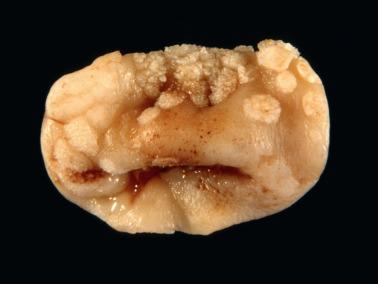
Most cervical LSILs are flat but can be variably papillary, and occasionally may appear as a typical exophytic condyloma acuminatum ( Chapter 1 ), larger examples of which can mimic a neoplasm. Occasional LSILs can exhibit striking downgrowth with involvement of endocervical glands (inverted condyloma).
In addition to the usual koilocytotic atypia ( Chapter 1 ), some LSILs contain cells with dysplastic features similar to those in HSILs (see below), but unlike the latter, such cells are predominantly within the lower third of the epithelium. The upper layers, which are usually koilocytotic, show maturation but usually contain at least some cells with mild nuclear atypia.
Mitotic figures, which may be abnormal, are common in LSILs, but are rare in the upper third of the epithelium. Ki-67 (MIB1) staining shows positivity mostly within the lower one-third of the epithelium with occasional scattered positive cells within the upper two-thirds of the epithelium. Even rare Ki-67+ cells in the upper two-thirds of the epithelium favor a condyloma vs a nonviral-related squamous papilloma or fibroepithelial polyp (Pirog et al.).
Koilocytes of LSILs have markedly diminished to absent cytoplasmic glycogen helping to distinguish them from normal cervical squamous cells that typically have abundant glycogen.
found that a subset of LSILs with marked atypia (≥5 cells with nuclear enlargement 5-fold greater than in normal intermediate cell nuclei or multinucleation with ≥5 nuclei) had a higher rate of progression to HSILs than typical LSILs (36% vs 7%), despite containing the same spectrum of HPV genotypes. However, Fadare and Rodriguez in a similar study found no difference in progression of LSILs with and without marked atypia.
p16 and HPV findings.
A spectrum of HPV subtypes occurs in LSILs, including low-risk types (LRHPV) that are typically present in condylomas (6, 11), intermediate-risk types (31, 33, 35), and high-risk types (HRHPV) (16, 18). Ordi et al. and Srodon et al. found HRHPV subtypes in ~90% of LSILs.
Nuclear and cytoplasmic p16 staining is typically present, but is usually focal and confined to the intermediate and superficial layers. This episomal staining pattern reflects the presence of LRHPV and/or HRHPV that are not yet integrated into the nuclei of the proliferating cells.
Rare LSILs with integrated HRHPV may show p16 staining in the lower third of the epithelium (or even higher), a pattern of staining that predicts progression to HSIL (see Natural History ), although found that p16 staining did not risk-stratify LSIL patients in a way that would alter recommended management for CIN 1.
Zhang et al. found that a new automated broad spectrum HPV in situ hybridization assay combined with H&E-stained slides contributed to better assessment of SILs than H&E-staining alone, and resulted in fewer false-positive CIN 1 (LSIL) results.
CK7 findings.
, Paquette et al., and Huang et al. found that CK7+ LSILs have an increased risk of future HSIL; Mills et al. finding that LSILs with full-thickness CK7 staining showed the highest rate of progression. Similarly, Cao et al. found that CK7+/HPV-L1 LSILs had a higher progression rate to HSIL than CK7−/HPV-L1+ LSILs.
Herfs et al., using squamocolumnar junction (SCJ)-specific markers (CK7, AGR2, MMP7, GDA), found that SCJ+ LSILs more commonly showed full-thickness p16 staining and progression to HSIL than did SCJ− LSILs.
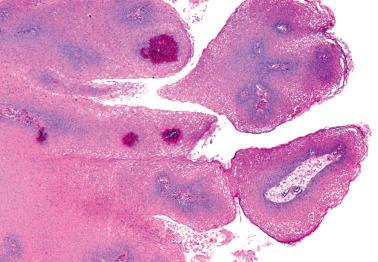
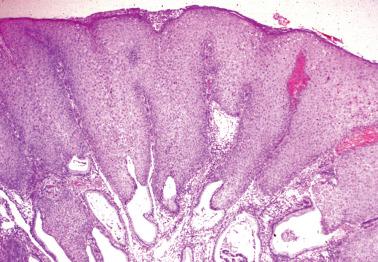
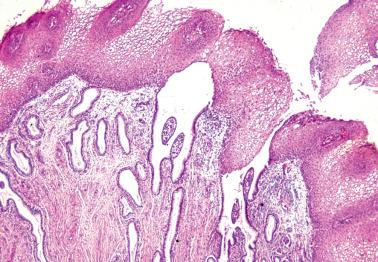
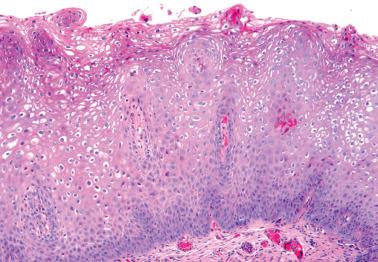
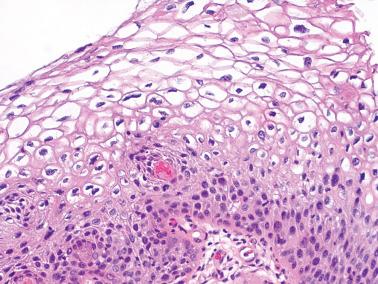
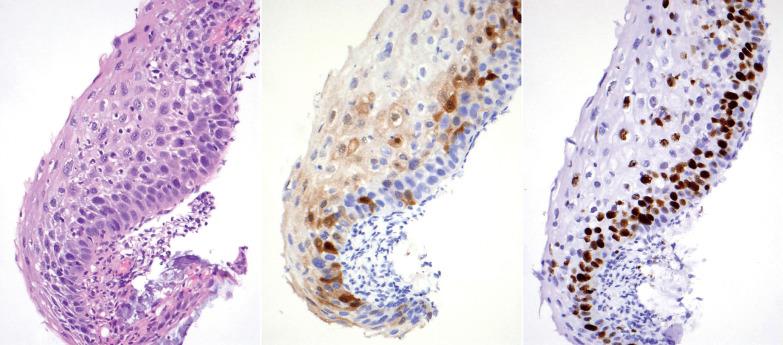
The cardinal feature is the presence of striking nuclear atypia in all epithelial layers, usually with loss of maturation. Some investigators, however, consider lesions with marked dysplastic atypia, even if confined to the basal layers, HSILs. The involved epithelium is often thickened but may be thin; the latter are defined by WHO as ≤9 cells in height and, according to Reich and Regauer, arise in “nonstratified or very thin immature squamous epithelium”.
HSILs with some maturation or koilocytotic atypia correspond to CIN 2, whereas those lacking maturation correspond to CIN 3. Koilocytes, when present, may be identical to those in LSILs, but often have smaller halos and more densely hyperchromatic and more pleomorphic nuclei.
The nuclear atypia includes enlargement, variation in size and shape, hyperchromasia, and coarse chromatin. The dysplastic cells are typically crowded and have indistinct cell membranes and overlapping nuclei and are typically aneuploid.
Cells with bizarre nuclei may be present, particularly deep within glands. These may be associated with invasion (see next heading) but in some cases are associated with a low Ki-67 index suggesting a degenerative phenomenon (Stewart).
Mitotic figures, normal and abnormal, are usually present in all layers. Mimica et al. found that >33% MIB1+ cells in the upper two-thirds of the epithelium was a highly specific and sensitive discriminator for HSIL vs LSIL. Similar findings were reported by Galgano et al., but they found that the use of MIB1 did not improve the diagnostic accuracy of HSIL provided by p16 staining alone (see next point).
Intense cytoplasmic and nuclear p16 positivity is typically present within the full thickness of the lesion or at least within its lower third (‘block positive’ staining) consistent with the presence of a HRHPV, most commonly HPV 16 (especially in younger women), less commonly types 18, 31, and others. Weak focal p16 staining is considered negative.
Block positive p16 staining helps confirm a diagnosis of HSIL vs LSIL and HSIL vs its benign mimics (see Differential Diagnosis ) and improves interobserver agreement in SIL grading.
p16 staining can disclose initially unappreciated foci of HSIL, especially in those with Pap tests showing HSIL or those testing positive for HRHPV (Ordi et al., Solano et al.), and can aid diagnosis of thin HSILs (see above).
Shah et al. found that p16 staining combined with recuts identified HSILs in 31% of ECC specimens originally interpreted as negative.
found that even ambiguous (nonblock) p16 staining predicted oncogenic HPV/HSIL in 16% of cases (vs 35% of those with block staining and 1.5% of those with negative staining).
Dolkar et al. categorized lesions in 23 cases (mostly cervical, some vaginal/vulvar/perianal) potentially classifiable as LSIL or HSIL on routine staining but with discrepant p16/Ki-67 findings into four groups:
1: Atypical morphology, favor HSIL but no increase in p16 or Ki-67; 2: atypical morphology with diffuse p16 but no increase in Ki-67; 3: atypical morphology with increased Ki-67 but no or patchy p16; 4: atypical morphology, favor reactive, no increase in p16 or Ki-67.
Follow-up (mean ~16 months) revealed at least some HSILs in all categories except category 3 in which only LSILs were found, these lesions possibly representing tangentially sectioned condylomas.
ProExC is a newer marker that targets the expression of genes overexpressed in cervical cancer. In contrast to nondysplastic lesions, almost all HSILs exhibit strong nuclear staining with ProExC within the full thickness (75–100%) of the lesion. Guo et al. found that using ProExC and p16 provided a higher specificity for the detection of HSIL than either marker alone.
Lu et al. found that expression of IMP3 (an oncofetal protein) was confined to a subset of CIN 3 lesions associated with ISqCC and that an IMP3+ CIN likely has an increased risk of progression to ISqCC.
Stewart and Crook found that CIN 3 usually showed increased SOX2 expression compared to normal epithelium, particularly in areas of crypt involvement and adjacent to superficial ISqCCs that were SOX2−.
Velez-Perez et al. found SIRT1 cytoplasmic overexpression in 13.8% of CIN 1s, 40.6% of CIN 2s, 50% of CIN 3s, and 96% of ISqCCs, suggesting its potential use for predicting progression of CIN to ISqCC.
found that HPV E6/E7 mRNA in situ hybridization assay covering 18 common high-risk types (HR-RISH) is a robust method for the detection of HR-HPV-related neoplasia.
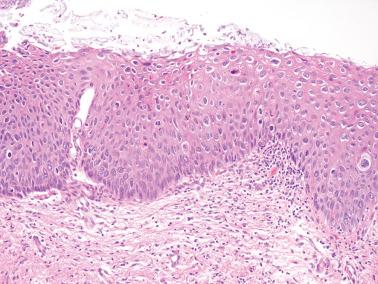
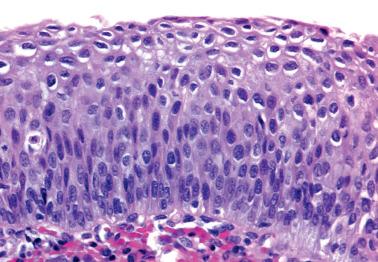
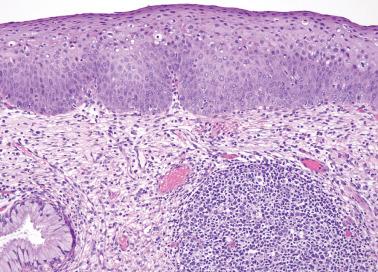
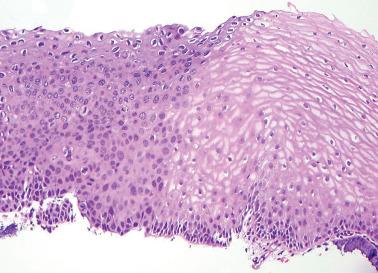
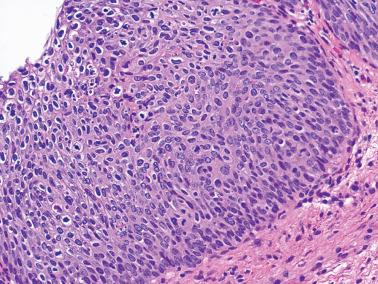
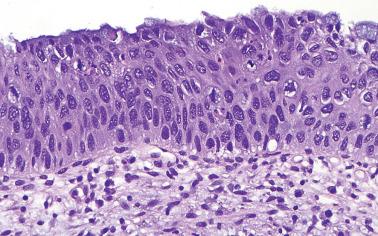
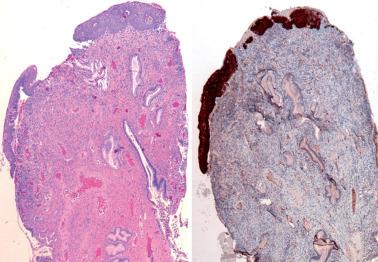
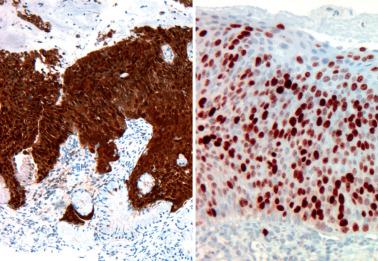
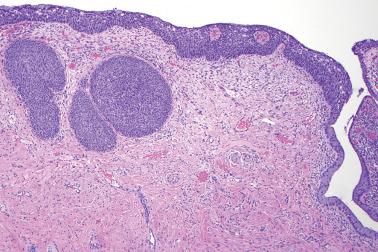
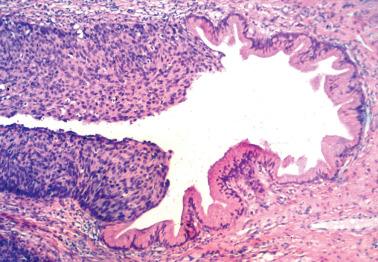
‘Deceiving’ HSILs (Kitahara et al.) have features intermediate between those of metaplasia and dysplasia: mild-to-moderate cellularity, no significant atypia, absent to rare mitoses, but diffuse p16, ProExC, and MIB1 staining, and HRHPV other than types 16/18. This variant should be considered when there is an abnormal Pap test and atypical histologic findings suggesting immature metaplasia.
‘Low-grade-like’ HSILs (Masand et al.). These HPV16−/18− (positive for other non-16/18 high-risk subtypes) lesions exhibit only mild-to-moderate nuclear atypia, mitoses confined to the basal layers, bi- or multinucleation in all layers, and in the superficial layers increased eosinophilia and/or glycogenation resembling koilocytosis. p16 staining is band-like but less intense superficially and the Ki-67 staining is full thickness.
HSILs with intracellular mucin droplets (‘squamomucinous intraepithelial lesion’). These represent an in situ counterpart of ISqCC with intracellular mucin.
‘Eosinophilic dysplasia’. Ma et al. consider this a CIN 2 variant. The lesional cells have abundant eosinophilic cytoplasm and distinct cell borders, and in >90% of cases, p16 and Ki-67 staining of typical HSILs; 70% of their cases were associated with conventional LSIL or HSIL.
Pigmented HSIL. Ishida et al. reported an HSIL that contained nonatypical pigmented melanocytes scattered amongst the dysplastic squamous cells; some of the latter also contained melanin.
SILs usually arise in the transformation zone (TZ) (the area between the original and the current squamocolumnar junction) within foci of metaplastic squamous epithelium; the anterior lip is involved twice as frequently as the posterior lip. Rare SILs are not located in the TZ, lying proximal (within the endocervix) or distal (on the ectocervix).
Rarely, SILs are confined to an otherwise typical endocervical polyp (Chin et al.). In such cases, the SIL is usually not detected by cervicovaginal smears
SILs spread laterally by replacing the metaplastic and glandular epithelial cells. Involvement of endocervical glands is common (especially with HSILs), often with luminal obliteration, a finding that should not be confused with early invasion. HSILs tend to involve a larger area and are more likely to extend into the endocervical canal than LSILs.
HSILs can extend for a variable distance up the endocervical canal. Rarely, they extend into the endometrium, fallopian tube, or even on to the ovarian surface, exceptionally giving rise to ISqCC.
HSILs associated with early stromal invasion often exhibit extensive involvement of the surface epithelium and deep, expansile glandular involvement, luminal necrosis, and maturation in the form of large keratinized cells and keratin pearls.
Other features include numerous mitoses and apoptotic bodies, severe nuclear pleomorphism including bizarre nuclei, distinct nucleoli, chromatin clearing, spindle cells oriented at right-angles to the basement membrane, and stromal fibrosis and inflammation. Stromal eosinophils may indicate early invasion.
Biopsy specimens of HSILs exhibiting these features should be serially sectioned to exclude early invasion. In the absence of the latter, a notation in the pathology report should indicate the possibility of invasion unsampled by the biopsy.
Condyloma (LSIL) vs squamous papilloma and fibroepithelial polyps. The presence of koilocytes is usually diagnostic of condyloma, but in its absence, any MIB-1+ cells in the upper two-thirds of the epithelium strongly favor condyloma (Pirog et al.).
Usual immature squamous metaplasia
In its early phases, metaplastic squamous epithelium is often composed of a monotonous population of cells with a high N:C ratio that lack the cytoplasmic maturation in the superficial layers present in mature squamous metaplasia.
In contrast to SILs, immature squamous cells have minimal crowding, absent to mild cytologic atypia, uniformly distributed fine chromatin, and smooth nuclear contours. Mitoses are uncommon and if present are typical and confined to the basal layers. The papillarity, koilocytosis, and p16 staining of papillary immature metaplasia (see below) are absent.
Florid squamous metaplasia that can be mistaken for ISqCC is discussed in Chapter 4 .
Papillary immature metaplasia (PIM)
PIM, which may extend into the endocervical canal, is characterized by filiform papillae composed of immature parabasal-type squamous cells with bland features. Endocervical columnar cells may persist on the surface of the lesion.
There is minimal cell crowding, well-defined cell membranes, an increased N:C ratio, smooth nuclear contours, and uniformly distributed, fine chromatin. Mitoses are uncommon and typical.
Superficial koilocytes are usually present focally, consistent with the usual presence of low-risk HPV. However, rare PIMs abut an HSIL, presumably due to a synchronous HRHPV infection.
PIMs have a low Ki-67 index in the mid and upper layers, in contrast to HSILs and most papillary squamous carcinomas (see corresponding heading), lesions with which PIM may be confused.
Atypical immature squamous metaplasia (AIM).
AIM has been applied to lesions with absent or minimal maturation of metaplastic squamous epithelium, absent or minimal koilocytosis, and mild nuclear pleomorphism; mitotic figures are rare and confined to the lower third of the epithelium. There is considerable interobserver variation in its recognition.
HPV and Ki-67 analyses indicate that AIMs are a heterogenous group that includes HSILs (HRHPV+, high Ki-67 index), possible precursors of HSILs (HRHPV+, absent to low Ki-67 index), and benign reactive lesions (HPV-, absent to low Ki-67 index).
Duggan et al. reclassified lesions originally diagnosed as AIMs as follows: negative (1.7%), benign (31.4%), AIM (34.9%), LSIL (25%), and HSIL (6.9%).
A benign diagnosis correlated with a low (<15%) Ki-67 index and negative or focal p16 staining whereas HSIL correlated with Ki-67 >15% and diffuse p16 staining. LSILs and AIMs had similar but highly variable Ki67 and p16 profiles. Of those with a review diagnosis of AIM, a SIL developed in 66% (50% LSIL, 16% HSIL) and correlated with p16 positivity.
This study concluded that because of their similar immunoprofiles and outcomes, AIM may be a morphologic type of LSIL.
Similarly, Kong et al. found that p16 was the best marker for the assessment of lesions indeterminate for dysplasia and that diffuse strong positivity for p16 was specific for the presence of HRHPV. Focal strong p16 staining was less specific and could be even found in normal squamous epithelium; this pattern of staining in an AIM requires further evaluation.
Regauer and Reich were able to reclassify lesions initially categorized as AIM as immature metaplasia (CK17+/p16 − ) or HSIL (p16+, usually but not always CK17 − ). They concluded that AIM is a helpful histologic descriptor but should not be used as a final diagnosis.
van der Marel et al. also concluded that p16+ AIMs should be diagnosed as HSIL and found them to be associated with HPV18; typical HSIL present in some cases was HPV18-negative.
Reactive and reparative changes
Reactive nuclear atypia, which may include nucleomegaly, hyperchromasia, and bi- or multinucleation, is usually confined to the lower layers (in contrast to SILs), with normal maturation and minimal nuclear enlargement in the upper layers. There may be a sharp demarcation between the atypical cells in the lower layers and the mature cells in the upper layers.
Unlike typical SILs, reactive cells often show spongiosis, distinct cell borders, regular nuclear spacing, prominent nucleoli or chromocenters, and an absence of marked variation in nuclear size and contour and coarse hyperchromasia. Cytoplasmic halos, if present, are round and uniform with central nuclei.
Intraepithelial neutrophils may be seen. Numerous neutrophils, ulceration, and necrotic cells should prompt a search for herpetic inclusions ( Chapter 4 ). Dense acute and chronic inflammation with lymphoid follicles (follicular cervicitis) suggests chlamydial infection ( Chapter 4 ).
Absence of p16 staining facilitates the distinction from SILs. Also, in contrast to HSILs, Ki-67 staining is usually confined to the lower third of the epithelium.
Postmenopausal squamous atypia (PSqA) and other forms of pseudokoilocytosis
PSqA, which usually occurs in women >50 years of age, is characterized by prominent perinuclear halos, no more than 2-fold nuclear enlargement, hyperchromasia, and multinucleation. These findings may be misdiagnosed as LSIL, but PSqA is negative for HPV. There may be associated atrophy and/or transitional cell metaplasia (see below).
Compared to koilocytotic atypia, PSqA has less variation in nuclear size (<2- vs >3-fold) and staining intensity and more finely and evenly distributed nuclear chromatin. The nuclei are uniformly spaced and slightly elongated and lie centrally within a uniformly contoured halo. Occasional nuclear grooves may be present; mitoses are rare or absent.
An absence of bi/multinucleated cells favors PSqA over koilocytotic atypia, whereas the presence of ≥2 binucleated cells in a high-power-field strongly suggests koilocytotic atypia.
Other forms of pseudokoilocytosis include those in which perinuclear halos occur as an isolated finding with no nuclear atypia (as in normal glycogenated squamous epithelium) or perinuclear halos with mild reactive atypia.
Transitional cell metaplasia (TCM) ( Chapter 4 ) and atrophy. These processes can suggest a SIL due to loss of the normal maturation and cells with a high N:C ratio, as can enigmatic p16 positivity in some TCMs. The absence of nuclear atypia and mitotic activity points to the correct diagnosis. Additionally, atrophic epithelium is thin and lacks Ki-67 and p16 staining. Rarely, however, a SIL can arise on a background of TCM.
ISqCC. In a study comparing HSILs to ISqCCs, it was found that two or more of the following features were highly suggestive of invasion in a biopsy specimen, even when stroma is absent or too scanty to assess invasion: giant bizarre cells, large keratinized cells, keratin pearls, necrosis, and neovascularization.
Radiation effect ( Chapter 4 ).
Placental site nodules and plaques ( Chapter 10 ).
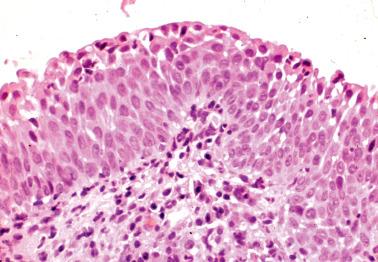
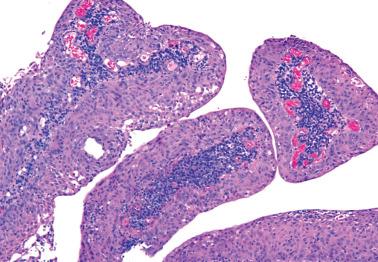
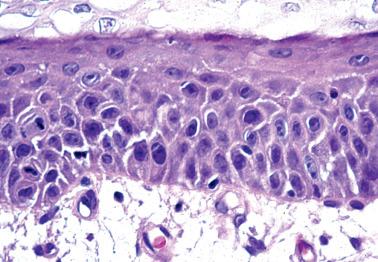
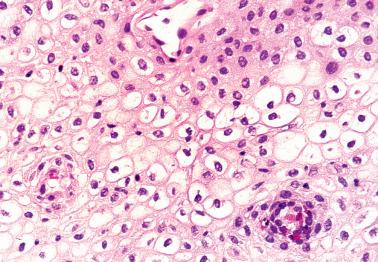
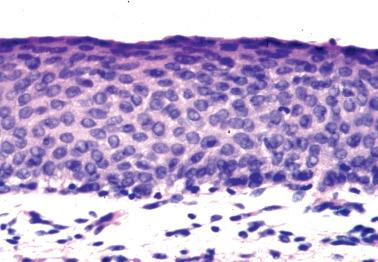
Follow-up studies of HSILs and the contiguity of most ISqCCs with an HSIL indicate that an HSIL precedes most ISqCCs. In >80% of cases, the first abnormal smear preceding an ISqCC shows HSIL, whereas LSILs in smears preceding ISqCCs are rare (1–3% of cases). Some ISqCCs have no previously documented precursor lesion.
Östör found the frequency of regression for CIN 1 to be 60%; persistence, 30%; progression to CIN 3, 10%; and progression to invasion, 1%. Ordi et al. found similar regression and persistence rates but a progression rate of 5.3%.
Progression of LSILs may represent the de novo development of HSIL or under-diagnosis of a previously sampled HSIL or a synchronous unsampled HSIL. Litjens et al. found that most metachronous LSILs and HSILs are caused by different HPV genotypes and that the presence of LSIL does not determine the risk of subsequent HSIL.
Negri et al. found that 62% of LSILs in which >25% of the cells in their lower thirds expressed p16 progressed to HSIL (suggesting the presence of HRHPV]), whereas those with fewer positive cells or that were p16-negative had only a 31% progression rate.
Cortecchia et al. also found that LSILs with p16 overexpression in the basal/parabasal layers had an increased risk of progression but mainly in the first year of follow-up.
Pretorius et al. found that 1.9% of women with CIN 1 or less (smears showing ASCUS or CIN 1) progressed to CIN 3 or cancer. The risk was higher in those with HRHPV (2.3% vs 0.4% for those without HRHPV) and those >30 years of age (2.7% vs 1.7% for those 20–29 and 0.4% for those <20).
Razmpoosh et al. found that LSILs with p16 staining in the lower third seldom progressed to HSIL whereas 25% of LSILs with diffuse p16 staining progressed to HSIL.
However, as noted previously, found that p16 staining did not risk-stratify LSILs in a way that would alter recommended management of CIN 1.
Sagasta et al. also found p16 staining to have limited value in predicting outcome of histologically LSIL.
As noted earlier (see Microscopic Features of LSILs ), CK7+ LSILs appear to have an increased risk of progression to HSIL.
The Östör review found that 40% of CIN 2 lesions regressed, 40% persisted, 20% progressed to CIN 3, and 5% progressed to ISqCC. Of CIN 3 lesions, 33% regressed, ‘<56%’ persisted, and ‘>12%’ progressed to ISqCC. Other studies have found as many as 70% of CIN 3 lesions progress to ISqCC.
Miralpeix et al., studying ‘CIN2/HSIL’ lesions, found spontaneous regression in 64%, persistence in 28%, and progression in 8%. Regression occurred in all p16− cases and 57% of p16+ cases.
Koeneman et al. found that the following were predictive of regression of CIN 2: a non-smoking patient, Papanicolaou class <3, synchronous CIN 1, and ≤1 biopsy containing CIN 2.
The above observations and those made by Zuna et al. indicate that the risk of progression in SILs is related to its grade and the HPV genotype. Nonetheless, the behavior of an SIL, even a HSIL and/or one harboring a HRHPV, cannot be predicted with certainty in any one case.
SILs may recur as SIL or ISqCC after their conservative ablation or even after hysterectomy, although some of these may represent new lesions. The risk of post-LEEP recurrences in some studies is higher with positive margins (Shaco-Levy et al.); contrarily, Kenwright et al. found that margin status had no affect on post-LEEP recurrence rates of LSILs or HSILs.
Diaz et al. found residual carcinoma or HSIL in nearly half of postconization hysterectomy specimens that were associated with a positive endocervical curettage, positive cone margins, or microinvasion.
Patients with cervical SILs are at risk for SILs elsewhere in the lower genital tract, particularly in the vagina. In some cases the cervical and extracervical lesions are monoclonal.
In an analysis of 20,810 women, Khan et al. found that HRHPV subtyping may identify a subset of women at higher risk of developing subsequent CIN 3 or higher lesions. The 10-year cumulative risk of developing a CIN 3 or higher lesion was 17.2% in HPV16-positive women, 13.6% in HPV18-positive women but only 3.0% in women positive for other (non-16/18) HRHPV subtypes.
Kjaer et al. found that persistence of subtypes 16, 18, 31, and 33 was associated with high absolute risk of progression to CIN 3 or higher lesions.
FIGO defines stage IA ISqCC as one identified only microscopically and with stromal invasion ≤5 mm in depth and ≤7 mm in width ( Table 5.2 ). CAP-ASCCP LAST defines superficially invasive squamous cell carcinoma in the same manner as FIGO defines a stage IA1 lesion (see below)
| Stage I | Carcinoma is confined to the cervix (extension to the corpus is disregarded) |
| IA | Invasive cancer that can de diagnosed only by microscopy, with deepest invasion ≤5 mm and greatest horizontal extension ≤7 mm |
| IA1 | Stromal invasion a ≤3 mm in depth and ≤7 mm in horizontal spread |
| IA2 | Stromal invasion >3 mm and ≤5 mm in depth with a horizontal spread ≤7 mm |
| IB | Clinical visible lesion confined to the cervix or microscopic lesion > stage IA2 |
| IB1 | Clinically visible lesion ≤4 cm in greatest dimension |
| IB2 | Clinically visible lesion >4 cm in greatest dimension |
| Stage II | The carcinoma extends beyond the uterus but not to pelvic wall or to lower third of the vagina |
| IIA | Without parametrial invasion |
| IIA1 | Clinically visible lesion 4.0 cm or less in greatest dimension |
| IIA2 | Clinically visible lesion more than 4.0 cm in greatest dimension |
| IIB | With parametrial invasion |
| Stage III | Tumor extends to pelvic wall and/or involves lower third of the vagina and/or causes hydronephrosis or nonfunctioning kidney |
| IIIA | Tumor involves lower third of vagina with no extension to pelvic wall |
| IIIB | Tumor extends to pelvic wall and/or causes hydronephrosis or non-functioning kidney |
| Stage IVA | Tumor invades mucosa of bladder or rectum and/or extends beyond true pelvis |
| Stage IVB | Distant metastases |
a The depth of invasion is measured from the surface or glandular epithelium (epithelial–stromal junction) from which it originates. Vascular space involvement (venous or lymphatic) does not alter the staging but should be recorded.
Stage IA ISqCC can only be diagnosed in conization or hysterectomy specimens that include the entire lesion. Clinically visible tumors are stage IB regardless of size.
Stage IA1 ISqCCs have stromal invasion ≤3 mm in depth and ≤7 mm in width. Stage IA2 lesions have stromal invasion >3 mm but ≤5 mm, and ≤7 mm in width. The depth of invasion is measured from the base of the epithelium from which it originates.
McIlwaine et al. found that multiple foci of invasion (defined as foci ≥2 mm apart) had a prognosis equivalent to unifocal lesions, justifying a stage of IA. Alternate approaches (adding up the width of each focus or measuring from one focus to the edge of the furthest invasive focus) can result in a breadth of ≥7 mm and an inappropriate stage of IB.
Day et al. concluded that multifocal lesions should be staged according to the largest individual focus of invasion. The outcomes were comparable to unifocal lesions, justifying similar management.
The proximity of the invasive tumor (and any associated SIL) to the resection margins should be noted. Lymphovascular space involvement (LVI) does not alter the staging but should be recorded.
In contrast to the foregoing, the SGO defines microinvasive carcinoma as one that invades the cervical stroma to a depth of ≤3 mm below the base of the epithelium and lacks LVI. Larger tumors and/or those with lymphatic invasion are stage IB.
Stage IA ISqCCs are found in about 5% of serially sectioned cone or LEEP biopsy specimens performed for HSILs. The mean patient age is 45 years, which is a decade younger than for ISqCCs in general.
The presenting clinical features are similar to those of patients with SILs. In some cases, the diagnosis of early invasion may be suspected on a Pap smear. Some patients have a visible colposcopic abnormality that differs from the surrounding HSIL.
Early stromal invasion appears as one or more tongues of neoplastic cells that have invaded through the basement membrane of SIL-involved surface or glandular epithelium. The SIL is usually widespread HSIL with extensive glandular involvement. Over 90% of lesions arise within the transformation zone, the remainder from the native ectocervical squamous epithelium.
Larger tumors may have a solid confluent pattern, numerous small nests widely separated by stroma (spray pattern), or both. Some early invasive lesions, as noted above, are multifocal.
The invasive foci usually show greater differentiation than the overlying SIL, including more abundant eosinophilic cytoplasm, intercellular bridges, and/or keratinization. Grading has not been of prognostic significance.
There is typically a stromal reaction to the invasive foci, that may include edema, fibrosis, lymphocytes, eosinophils, and, occasionally, a granulomatous response to keratin.
Staining for cytokeratin and basement membrane (laminin or collagen IV) shows that early invasive foci, unlike the associated HSIL, have a discontinuous or absent basement membrane.
LVI may alter treatment and prognosis (see below). The frequency of LVI increases with the depth of invasion, one study finding frequencies of 4.4% (<1 mm), 16.4% (1–2.9 mm), and 19.7% (3–5 mm).
When the margins of the cone or LEEP specimen show SIL and/or invasive tumor, there is a high risk of invasive tumor in the hysterectomy specimen (70% vs 5% with negative margins).
Findings associated with HSILs that may indicate the presence of early invasion are considered earlier under a separate heading.
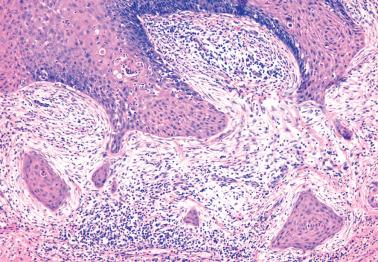
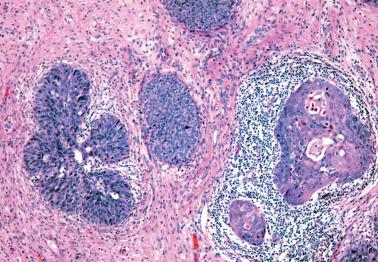
Non-neoplastic lesions including florid squamous metaplasia ( Chapter 4 ), postbiopsy pseudoinvasion of squamous epithelium ( Chapter 4 ), ectopic decidua ( Chapter 4 ), and placental site nodule ( Chapter 10 ). PreLEEP cervical lidocaine injection can cause artifactual pseudoinvasion of vascular spaces by an SIL.
Endocervical gland involvement by SILs. Involved glands maintain the location and configuration of normal endocervical glands, have a smooth border with the endocervical stroma, and lack the maturational and stromal changes of early ISqCC.
Become a Clinical Tree membership for Full access and enjoy Unlimited articles
If you are a member. Log in here